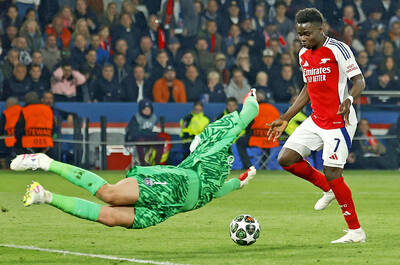South Korean officials have ruled out turning a state-of-the-art Olympic skating arena into a giant seafood freezer. Other than that, not much is certain about the country’s post-Winter Games plans for a host of expensive venues.
As officials prepare for the Games in and around the small mountain town of Pyeongchang, there are lingering worries over the huge financial burden facing one of the nation’s poorest regions. Local officials hope that the Games will provide a badly needed economic boost by marking the area as a world-class tourist destination.
However, past experience shows that hosts who justified their Olympics with expectations of financial windfalls were often left deeply disappointed when the fanfare ended.

Photo: EPA-EFE
This is not lost on Gangwon Province, which governs Pyeongchang and nearby Gangneung, a seaside city that is to host Olympic skating and hockey events. Officials there are trying hard to persuade the national government to pay to maintain new stadiums that will have little use once the athletes leave.
However, Seoul is so far balking at the idea.
The Olympics, which begin on Feb. 9, are to cost South Korea about 14 trillion won (US$12.9 billion), much more than the 8 trillion to 9 trillion won the country projected as the overall cost when Pyeongchang won the bid in 2011.
Worries over costs have cast a shadow over the Games among residents long frustrated with what they have said were decades of neglect in a region that does not have much going on other than domestic tourism and fisheries.
“What good will a nicely managed global event really do for residents when we are struggling so much to make ends meet?” Gangneung restaurant owner Lee Do-sung said. “What will the Games even leave? Maybe only debt.”
The atmosphere was starkly different three decades ago when grand preparations for the 1988 Seoul Summer Games essentially shaped the capital into the modern metropolis it is today.
A massive sports complex and huge public parks emerged alongside the city’s Han River. Next came new highways, bridges and subway lines. Forests of high-rise buildings rose above the bulldozed ruins of old commercial districts and slums.
The legacy of the country’s second Olympics will be less clear. In a country that cares much less now about the recognition that large sporting events bring, it will potentially be remembered more for things dismantled than built.
The picturesque Olympic Stadium — a pentagonal 35,000-seat arena situated in a county of 40,000 people — will only be used for the opening and closing ceremonies of the Olympics and Paralympics before workers tear it down.
A scenic downhill course in nearby Jeongseon is also to be demolished after the Games to restore the area to its natural state.
Fierce criticism by environmentalists over the venue being built on a pristine forest sacred to locals caused construction delays that nearly forced pre-Olympic test events to be postponed.
Gangwon officials want the national government to share costs for rebuilding the forest, which could total as much as 102 billion won.
Despite more than a decade of planning, Gangwon remains unsure what to do with the Olympic facilities it will keep.
Winter sports facilities are often harder to maintain than summer ones because of the higher costs for maintaining ice and snow, and the usually smaller number of people they attract. That is especially true in South Korea, which does not have a strong winter sports culture.
Not all ideas are welcome.
Gangwon officials said they never seriously considered a proposal to convert the 8,000-seat Gangneung Oval, the Olympic speed skating venue, into a refrigerated warehouse for seafood.
Officials were unwilling to have frozen fish as part of their Olympic legacy.
Gangwon officials also dismissed a theme park developer’s suggestion to make the stadium a gambling venue, where people place bets on skating races, citing the country’s strict laws and largely negative view of gambling.
A plan to host a corporate league hockey team in the 10,000-capacity Gangneung Hockey Center fell apart.
Even worse off are Pyeongchang’s bobsled track, ski jump hill and the biathlon and cross-country skiing venues, which were built for sports South Koreans are largely uninterested in.
After its final inspection visit in August, the International Olympic Committee warned Pyeongchang’s organizers that they risked creating white elephants from Olympic venues, although it did not offer specific suggestions for what to do differently.
Cautionary tales come from Athens, which was left with a slew of abandoned stadiums after the 2004 Summer Games that some have said contributed to Greece’s financial meltdown and Nagano, the Japanese town that never got the tourism bump it expected after spending an estimated US$10.5 billion for the 1998 Winter Games.
Some Olympic venues have proved to be too costly to maintain. The US$100 million luge and bobsled track built in Turin, Italy, for the 2006 Games was later dismantled because of high operating costs.
Pyeongchang will be only the second Olympic host to dismantle its ceremonial Olympic Stadium immediately after the Games — 1992 Winter Olympics host Albertville, France, did so as well.
Gangwon has demanded that the national government in Seoul pay for maintaining at least four Olympic facilities after the Games — the speed skating arena, hockey center, bobsled track and ski jump hill.
This would save the province about 6 billion won per year, Gangwon official Park Cheol-sin said.
However, the national government has said doing so would be unfair to other South Korean cities that struggled financially after hosting large sports events.
Incheon, the indebted 2014 Asian Games host, has a slew of unused stadiums now mocked as “money-drinking hippos.”
It would also be a hard sell to taxpayers outside of Gangwon, South Korean Ministry of Culture, Sports and Tourism official Lee Jae-soon said.
Unlike the 1988 Olympics and the 2002 World Cup, which hosted in South Korea after bids driven by the national government, the provincial government led the bid for the Pyeongchang Games, and it did so without any commitment from Seoul over footing the bill.
Under current plans, Gangwon would be managing at least six Olympic facilities after the Games.
These facilities are to create a 9.2 billion won deficit for the province every year, a sizable burden for a quickly aging region that had the lowest income level among South Korean provinces in 2013, according to the Korea Industrial Strategy Institute, which was commissioned by Gangwon to analyze costs.
South Korea, a rapidly aging country with a worsening job market and widening rich-poor gap, has by far the highest elderly poverty rate among rich nations, Organisation for Economic Co-operation and Development data showed.

Freddie Freeman homered and drove in four runs, Shohei Ohtani also went deep and Roki Sasaki earned his first major league win as the Los Angeles Dodgers beat the Atlanta Braves 10-3 on Saturday night for their seventh straight victory. The Dodgers have won the first two games of the series to improve to 5-0 against Atlanta this year. Los Angeles’ three-game sweep at home early in the season left the Braves 0-7. Sasaki allowed three runs and six hits over five innings. The 23-year-old right-hander gave up a home run to Ozzie Albies, but received plenty of offensive support in his

INTER AWAIT: Superb saves by PSG ’keeper Gianluigi Donnarumma inspired the victory, as Arsenal were punished for misses, including one by Bukayo Saka Arsenal on Wednesday fell short on the big stage again as their painful UEFA Champions League semi-final exit against Paris Saint-Germain left Mikel Arteta to rue his club’s failure to provide him with enough attacking options. Arteta’s side were unable to reach the Champions League final for the first time in 19 years as PSG clinched a tense 2-1 win at Parc des Princes. Trailing 1-0 from last week’s first leg in London, the Gunners made a blistering start to the second leg, but could not convert their chances as Gianluigi Donnarumma’s superb saves inspired PSG’s 3-1 aggregate victory. Arsenal were punished for

Bayern Munich on Sunday were crowned German champions for the 34th time, giving striker Harry Kane his first major trophy, after second-placed Bayer 04 Leverkusen drew 2-2 at SC Freiburg. Bayern’s 3-3 draw at RB Leipzig on Saturday, when the Bavarians came from two goals down to take the lead before conceding a stoppage-time equalizer, meant defending Bundesliga champions Leverkusen needed to win at Freiburg to delay the title party. Leverkusen were two goals down before scoring twice in the final 10 minutes, but Xabi Alonso’s side could not find a third, as Bayern reclaimed the title at the first attempt after

THRILLER: Raphinha gave Barca a 3-2 lead with two minutes remaining of regular time, but Francesco Acerbi equalized the game in the second minute of added time Davide Frattesi on Tuesday fired Inter into the UEFA Champions League final with an extra-time winner that gave the Italians a stunning 4-3 triumph over Barcelona, 7-6 on aggregate. Italy midfielder Frattesi won a tie for the ages under a downpour in Milan when he lashed home in the 99th minute, sending a packed and rocking San Siro wild with joy. Simone Inzaghi’s team will face either Arsenal or Paris Saint-Germain at the end of this month in Munich, Germany, where they would feel they have a great chance to be crowned kings of Europe for a fourth time after